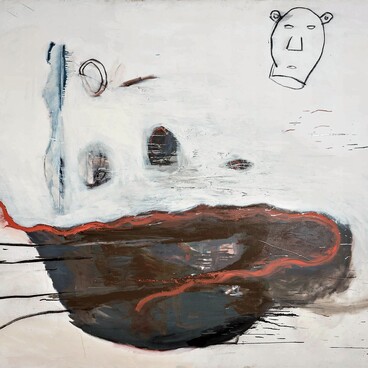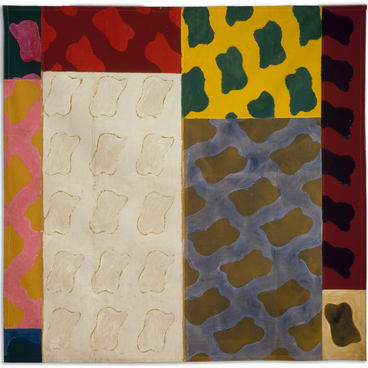The contemporary French artist Pierre Nivollet characterizes his works as “excess and squander” — the words he uses to describe the flow of vague images that appear when artists trust to luck and rely on the painting process.
The Dictionary of the Russian Language by Sergey Ozhegov provides the first meaning of the word “эксцесс” (excess) as an extreme manifestation of something, extravagance, and intemperance. It also denotes an acute and undesirable situation that disrupts the natural order of things.
Nivollet’s motto of “excess and squander” was embodied in the painting “Landscape”. The color areas have no clear outlines: blue merges with light brown, and violet — with green. The only figurative element in the work is the house that seems to have been drawn by a child.
In contemporary art, figurative art is a movement that seeks to capture an object while retaining its likeness to the real world. This term was first used in Great Britain to refer to the works opposite to abstract paintings. It also included pictures that at the time did not belong to any of the already existing and clearly defined trends. Contemporary figurative artists often include surreal and conceptual elements in their paintings if they seek to reveal a certain idea.
Pierre Nivollet has used such elements from the material world in his works since 1980. They represent the process of transformation occurring during the process of painting: when an object turns into an abstraction, and an idea winds up materialized.
Pierre Nivollet was born in Dijon in 1946. He founded the magazine called “Documents sur” and from 1978 to 1980 was on its editorial board together with Dominique Thiolat, Jean-Yves Langlois, Christian Sorg and others. The French poet and Nivollet’s close friend Marcelin Pleynet became the magazine’s literary adviser.
In the 1980s, Nivollet was engaged in literary consulting and editing. During that time, around ten of his solo exhibitions were organized in museums of France, Luxembourg, Malta and the Federal Republic of Germany. In the 1990s, Pierre Nivollet designed the scenery and costumes for Florence Didier-Lambert, a dancer at the Paris Opera House.
Works of Pierre Nivollet can be found in the Musée National d’Art Moderne in Paris, the Carnegie Museum of Art in Pittsburgh, USA, the National Museum of History and Art in Luxembourg, and other famous galleries.
The Dictionary of the Russian Language by Sergey Ozhegov provides the first meaning of the word “эксцесс” (excess) as an extreme manifestation of something, extravagance, and intemperance. It also denotes an acute and undesirable situation that disrupts the natural order of things.
Nivollet’s motto of “excess and squander” was embodied in the painting “Landscape”. The color areas have no clear outlines: blue merges with light brown, and violet — with green. The only figurative element in the work is the house that seems to have been drawn by a child.
In contemporary art, figurative art is a movement that seeks to capture an object while retaining its likeness to the real world. This term was first used in Great Britain to refer to the works opposite to abstract paintings. It also included pictures that at the time did not belong to any of the already existing and clearly defined trends. Contemporary figurative artists often include surreal and conceptual elements in their paintings if they seek to reveal a certain idea.
Pierre Nivollet has used such elements from the material world in his works since 1980. They represent the process of transformation occurring during the process of painting: when an object turns into an abstraction, and an idea winds up materialized.
Pierre Nivollet was born in Dijon in 1946. He founded the magazine called “Documents sur” and from 1978 to 1980 was on its editorial board together with Dominique Thiolat, Jean-Yves Langlois, Christian Sorg and others. The French poet and Nivollet’s close friend Marcelin Pleynet became the magazine’s literary adviser.
In the 1980s, Nivollet was engaged in literary consulting and editing. During that time, around ten of his solo exhibitions were organized in museums of France, Luxembourg, Malta and the Federal Republic of Germany. In the 1990s, Pierre Nivollet designed the scenery and costumes for Florence Didier-Lambert, a dancer at the Paris Opera House.
Works of Pierre Nivollet can be found in the Musée National d’Art Moderne in Paris, the Carnegie Museum of Art in Pittsburgh, USA, the National Museum of History and Art in Luxembourg, and other famous galleries.



